Is North Carolina Going to Flood Again
On this page yous learn what types of flooding are typical in North Carolina and how do you protect yourself, your family and your dwelling house. You will also find out more about significant North Carolina floods. Finally, you'll find links to NWS offices that provide forecast and safe information for Due north Carolina, also equally links to our partners who play a significant role in keeping you prophylactic.
Meaning North Carolina Floods
+1928 Okeechobee Hurricane
The Okeechobee Hurricane in 1928 decimated Puerto Rico and south
Florida virtually Palm Embankment before moving northward through Georgia and the Carolinas where it maintained tropical storm intensity. While the tempest caused minimal wind damage as it moved through North Carolina, the storm did produce four to nine inches of rain over eastern North Carolina. Rainfall amounts of this magnitude are common for wearisome moving tropical systems and typically practise not result in extreme flooding; however, this rain cruel at a fourth dimension when rivers in eastern North Carolina were high as they were in receding from heavy rainfall earlier in the month.
The resulting alluvion produced crests that were records, or near tape, up to that time for many locations in eastern North Carolina. Even at present, the resulting crests remain in the top v for many area cuff locations. These sites include the Cape Fear River at Fayetteville (fourth), the Cape Fear River at Elizabethtown (3rd), the Northeast Greatcoat Fear River at Chinquapin (2nd), the Tar River at Tarboro (fifth), and the Neuse River at Kinston (5th). The crest on the Waccamaw River at Conway, SC, remains the record for the site so it is probable that the crest at Freeland was higher than that of Hurricane Floyd in 1999. Additionally, the Lumber River at Lumberton crested at its highest level always as did the Lumber River at Boardman. The tape at Boardman nonetheless stands.
News reports for the event are somewhat sketchy, in function due to the focus on the horrific destruction the hurricane produced in Puerto Rico and Florida, just hundreds of Carolina homes were flooded. Especially hard hitting were Lumberton, where hundreds were left homeless, and Hoppersville, virtually Kinston, where water was reported to be lapping at the rooftops of deserted homes. In Canetuck Township in Pender Canton, 175 people were isolated every bit the flooding from the Cape Fear and Black Rivers prevented them from evacuating. The Red Cross and Army Corps of Engineers delivered relief supplies by boat. Several other towns were as well temporarily isolated and ran low on supplies. Transportation was greatly affected with roads and track lines flooded or cut by flood waters. Rail and bus service between towns was express for several weeks because bridges and track lines were out of service.
Full holding and crop damage is not known. Robeson County alone had thousands of dollars in damage to homes and approximately $i million in crop damage. Remarkably, a like upshot occurred in October 1929, with crests generally lower than in 1928; nonetheless, the resulting crop damage in these 2 years prompted the U.S. Senate to laissez passer a $half dozen million farm relief pecker for the Southeast in 1930.
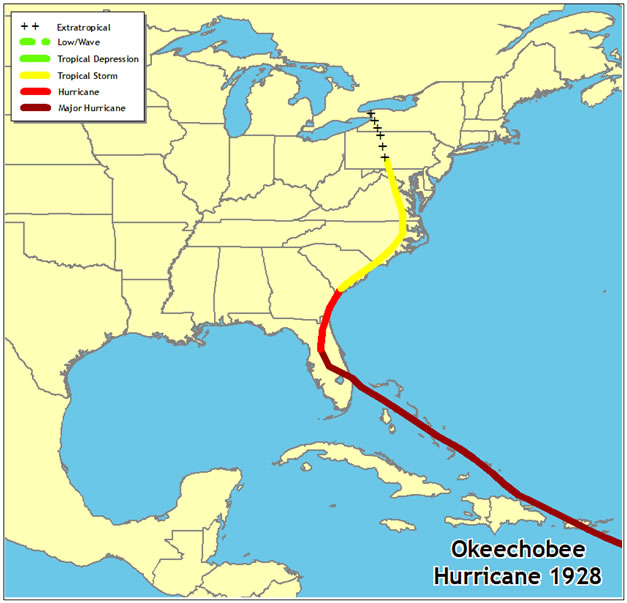
Path of the Okeechobee Hurricane September 10 to 20, 1928, courtesy the National Hurricane Center
+The Swell Catawba River Flood of 1916
Two tropical cyclones wreaked havoc on western North Carolina in July 1916. The get-go storm, a major hurricane, made landfall on the Gulf Coast of Alabama on July 5. The storm then moved slowly north, producing heavy rainfall over the mountains and foothills of N Carolina as it weakened and prodigal over southeast Tennessee a few days later. This tempest produced no flooding, but the ground was thoroughly saturated and streams were running high when the 2d tempest, a Category two hurricane, made landfall on the South Carolina coast on July 14. This storm moved west and passed over Charleston and Columbia, reaching the southern North Carolina mountains on the 15th and 16th as a tropical storm. Record rainfall was widespread, with one observer in Altapass, NC, recording 22.22 inches of rain for the 24-60 minutes menses from 2 pm, July fifteen-16.
The flooding resulting from the 1-two dial of these cyclones was devastating. The French Broad river, which flows through Asheville and westward into the Tennessee river, crested an estimated 17 feet above flood stage. Fifty-fifty higher readings, upwards to 23 feet above previous loftier h2o records, were recorded forth the Catawba River, which flows out of the mountains southeast to near Charlotte and into South Carolina. Destruction and loss of life was widespread along both rivers. At least 80 individuals were killed and numerous homes, factories, railroads, and bridges were destroyed. Hundreds of landslides destroyed farms and roads in the mountains.
Information technology is hard to put a contemporary equivalent dollar value on the impairment, but one early account estimates harm at $22 1000000, which equates to around $500 million in 2013.
| |
| |
| |
| |
| |
Larn More than:
- The North Carolina Inundation: July 14,15,16, 1916 (This source contains many eyewitness accounts of the destruction and detailed heroic rescue and survival efforts)
- The Floods of July 1916: How the Southern Railway Met an Emergency
+The 1940 Flood
A widespread major flood result in Baronial 1940 resulted from a landfalling tropical cyclone's decay and interaction with topography over western Northward Carolina during mid-August. This widespread and especially devastating flood is found in many accounts of historic events in local newspaper archives.
The hurricane'south rails was particularly conducive to producing extremely heavy rainfall due to slow movement and its initial motion to the due west and subsequent northward curlicue, which maintained deep and moist upslope flow on the eastern slopes of the Appalachians.
The storm produced heavy rain over a 5-day catamenia, from the 12th through the 16th, with rainfall exceeding 8 inches over well-nigh locations in the mountains. More than 12 inches of rain was recorded at Boone (12.11"), Hickory (12.45"), Highlands (12.80"), Crossnore (14.37"), and Mt. Mitchell (14.42"). Idlewild, in Ashe County, recorded a stunning 20.23 inches in just v days.
Individual property and ingather harm was widespread. In add-on, extensive damage to rail lines, bridges and roads caused major disruption to transportation. No official damage estimates could be located for this event, merely one reference states that the damage "probably exceeded $20 1000000," which would be well over $330 million today. The flash flooding and hundreds of resulting debris flows acquired 26 fatalities in the state, mainly in the Pigeon River bowl (Avery, Watauga, Ashe, Buncombe, McDowell, Yancy and Wilkes counties). There are still 8 river gages in northwest North Carolina where the historical loftier h2o levels are attributed to this alluvion.
Excerpted fromA Flood Story for a Rainy 24-hour interval "The coiffure knew in their hearts that they were making the last trip, because the line they were passing over had fabricated little coin, and the damage this flood would cause would seal the fate of the Linville River Railway. The rain connected unabated through the day every bit the train made its trip to Johnson City and began its return into the mountains. Every bit they began the climb upwardly into Cranberry Gap, a man flagged the train down and told the crew they were heading into a washout. As they began backing toward Cranberry, they encountered another, where a canal had failed. And so Number ix'due south journey ended on the loma between Cranberry and the Gap.
"At 7:20 am, Engineer Sherman Pippin opened the throttle, Conductor Cy Crumley hopped up the steps of the combine, and the concluding train ever departed Boone, leaving 14 freight cars behind in the yard. 'Escaped from Boone' would exist also an appropriate fashion to describe this departure, since rain was coming downwardly in sheets. The ground, saturated from days of wet conditions, could no longer absorb the rapidly falling water, so it cascaded downwardly the mountainsides, swelling streams and rivers. At Shulls Mills, the train waded through ii feet of water (try doing THAT with a diesel), and passed Granddad Mountain where information technology looked similar the entire mountainside was a behemothic waterfall."
"'Tweetsie Tales'" tells of how much rain barbarous in the catamenia ending at 5 pm on Baronial xiii, 1940, information technology too tells that several more inches fell between 5 and 6 in an intense cloudburst. My father, who was 13 then, has shown me how high the water got in North Wilkesboro. The flood'southward furnishings were visible for months, and the memories lasted for the lives of those who experienced it. Boone never saw another train."
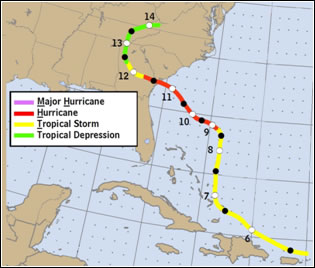
Track of the 1940 hurricane from the National Hurricane Center, National Weather Service archive
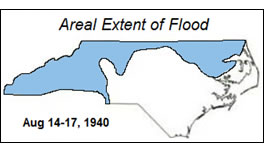
Extent of the flooding, which was of much greater severity in the west, encompassing the French Wide, Catawba, Upper Yadkin, and New River basins; paradigm is from the Usa Geological Survey, Water-Supply Paper 2375, National Water Summary 1988-89, page 428 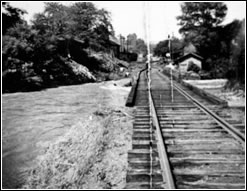
This photo shows the damaged trestle over Scotts Creek behind what is now Ward's Plumbing. Concluding week marked the 72nd anniversary of the largest and most devastating inundation recorded on the Tuckaseigee (sic) River. Iv casualties were reported after torrential rains caused what expanse residents at the time termed "cloudbursts" and "waterspouts," sending torrents of water from Canada and Caney Fork downwards the river. Alluvion waters wiped out every span in the county that crossed the Tuckaseigee (sic). The N.C. 107 span that spans the river's East Fork at Tuckasegee remained intact, only both approaches were washed away and rendered the bridge unusable for a time. This photo and the ones in this gallery were given to The Herald in 1980 past Herbert Gibson, a former Sylva resident, who discovered his undeveloped picture show 40 years afterward he captured images of the flood's devastation. Flood waters crested before daylight, so Gibson'southward pictures show the river at alluvion stage but well below the 21.1-foot high water marking reached during the night." Â Photo and caption credit: The Sylva Herald
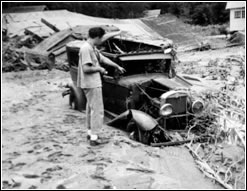
Last week marked the 72nd anniversary of the largest and well-nigh devastating alluvion recorded on the Tuckaseigee(sic) River. Four casualties were reported subsequently torrential rains acquired what area residents at the time termed "cloudbursts" and "waterspouts," sending torrents of h2o from Canada and Caney Fork down the river. Alluvion waters wiped out every bridge in the county that crossed the Tuckaseigee(sic). The N.C. 107 bridge that spans the river's East Fork at Tuckasegee remained intact, only both approaches were washed away and rendered the span unusable for a time. This photo and the ones in this gallery were given to The Herald in 1980 by Herbert Gibson, a former Sylva resident, who discovered his undeveloped pic twoscore years after he captured images of the flood'southward devastation. Alluvion waters crested before daylight, so Gibson'south pictures evidence the river at inundation stage just well below the 21.one-foot loftier water marker reached during the nighttime. ."
Acquire More:
- Digital Heritage Commodity
+The "Homestead" Hurricane of 1945
This astringent hurricane derives its proper name from its initial point of landfall, Homestead, FL, on September 15, 1945. This Category 4 hurricane acquired enormous harm in the Miami area before veering to the due north and weakening to tropical storm strength every bit it crossed central North Carolina on September 17. Fifty-fifty in its weakening land, torrential pelting ranging up to 8 inches cruel over a large swath of central Due north Carolina. This lonely would accept been enough to cause moderate to major flooding, but the tempest had been preceded by 3 to 5 days of rain earlier in the calendar month. There was thus picayune storage chapters in the soil or the streams to handle an additional two months of rain falling in a 24-hr. The resulting flooding is regarded as the worst on record for Piedmont rivers, including the Neuse, Cape Fright, Lumber, and PeeDee river basins. This effect served as a main example of alluvion potential and ultimately resulted in the creation of Falls Lake and B. Everett Jordan Lake.
The flooding from this cyclone produced historic crests at every point along the Cape Fear River, many of which remain several anxiety higher up the next highest crest on record. For example, the historic crests at the river gages in Lillington (33.2 feet) and Elizabethtown (43.2 feet) are more than than iv feet above the next highest historical crests.
Despite the magnitude of the flooding, there were simply a few deaths reported, probably due to the slow response of Piedmont rivers. For case, the historic crest of 68.9 feet at the gage in Fayetteville (alluvion stage is 35 feet) was reached on the 22nd, almost 4 days afterwards the bulk of the rain had fallen. Economic losses, on the other paw, were enormous, with vast areas of crops flooded and h2o reaching the eaves of homes along the rivers. Flooding along the Cape Fear in the Fayetteville area lasted more than a week. No damage estimate for the entire consequence could be constitute, just structural damage in Fayetteville lonely was more than $two million dollars ($25 million dollars in 2013).
Rail of the 1945 hurricane from the National Hurricane Center, National Conditions Service archive.
Extent of the flooding, encompassing the Neuse, Cape Fear, and PeeDee river basins. Epitome is from the United States Geological Survey, H2o-Supply Paper 2375, National H2o Summary 1988-89, page 428.
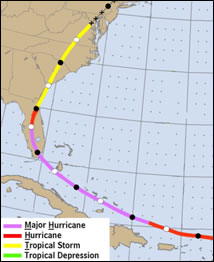
Rail of Hurricane, National Hurricane Center
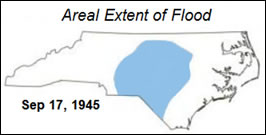
Extent of Areal flooding, National Weather condition Service
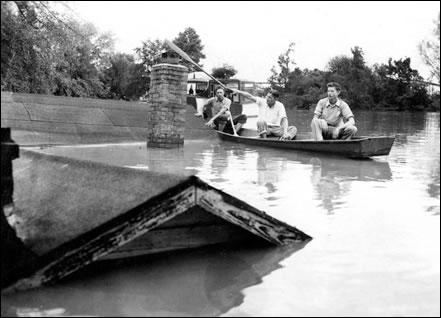
Flooding in Fayetteville, NC., Source, Fayetteville Observer, photograph from The Pecker Belch Collection
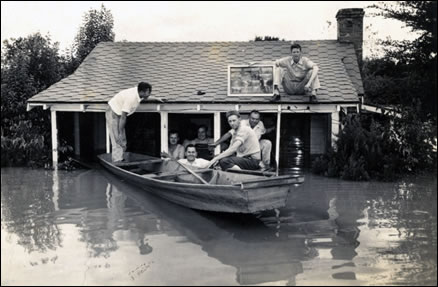
Flooding in Fayetteville, NC. Source: Fayetteville Observer; photo from The Nib Belch Collection
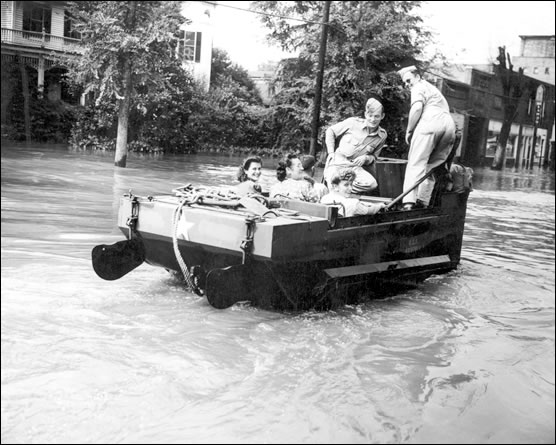
Flooding in Fayetteville, NC. Source: Fayetteville Observer; photo form The Pecker Belch Collection
Learn More:
- "Remember this? Downtown Fayetteville flood of 1945," photos
- Wikipedia: the Homestead Hurricane
+Hurricane Floyd (1999)
Hurricane Floyd produced unprecedented flooding across much of eastern North Carolina in September 1999. Floyd formed nigh the Cape verde Islands and traversed the Atlantic Ocean before crossing the Bahamas every bit a Category iv Hurricane. Floyd flirted with the Florida declension and continued northward making landfall equally a Category 2 in Greatcoat Fear, NC, on September xvi. The storm moved north and east across eastern North Carolina and southeastern Virginia, reemerging in the Atlantic briefly. As Floyd continued the track north, it lost much of its tropical characteristics crossing Long Island to Maine. Floyd yielded the largest mass hurricane evacuation to date in U.S. history.
Hurricane Floyd impacted many people across the Bahamas and the U.Southward. East Coast with devastating flooding, storm surge, current of air and tornadoes. In total, there were 57 deaths, 56 in the U.S., and 1 in Grand Bahamas Island. Nearly deaths were attributed to freshwater flooding. Total damage estimates ranged from $3 to $6 billion.
The hardest hit area was eastern Northward Carolina with 35 deaths, mainly related to inland freshwater flooding. Over vii,000 homes were destroyed and approximately 17,000 homes deemed uninhabitable. Extensive heavy rainfall resulted in flooding of nearly roads e of I-95. Eastern N Carolina recorded 15 to 20 inches of rain with 24.06 inches measured in Southport, NC. The Tar River in Tarboro crested over 22 feet above flood stage. Winds were potent with sustained winds of 45 to 70 mph inland, 70 to 90 mph forth the declension and around 100 mph along the immediate coastline and littoral waters. These impacts resulted in more than than 1,500 people rescued from flooded areas, 500,000 customers without electricity, and 10,000 people housed in temporary shelters.
Because of its large size and powerful winds, Hurricane Floyd resulted in a significant storm surge along coastal areas of the state. The maximum surge accompanied high tide aiding in overwash, dune retreat and harm to property along the barrier islands. Storm surge reached 10 to 15 feet above ground level in some locations along the south facing beaches. Floyd also spawned 15 tornadoes across Eastern North Carolina with some structural harm. There was also astringent agronomical harm throughout the eastern part of the state. In Duplin county alone, near 750,000 turkeys and 100,000 hogs were lost to flooding. This led to wellness concerns across the surface area. Total crop loss was around $432 one thousand thousand and total agronomical losses effectually 634 one thousand thousand dollars for a majority of the area inside the Northward Carolina Disaster Declaration.
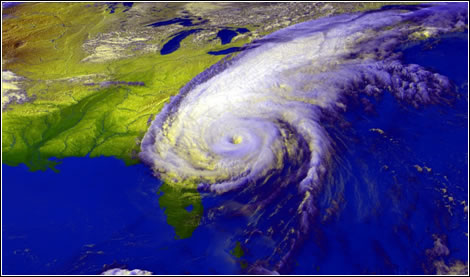
Satellite image of Hurricane Floyd, September xv, 1999, from NOAA GOES satellite; images produced by Hal Pierce, Laboratory for Atmospheres, NASA Goddard Space Flight Center.
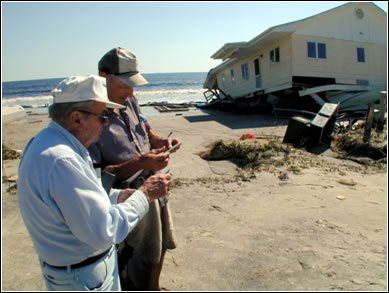
Long Beach, NC, September 17, 1999: The devastating 15-human foot storm surge that accompanied Hurricane Floyd damaged or destroyed hundreds of houses forth this community's sea front and flattened its frontal sand dunes. Here, 81 year old Mike Semancik, left, and his friend Bob Grazetti, right, use photographs to document the damage. Photo by Dave Gatley, FEMA News Photo
Storm total precipitation in inches
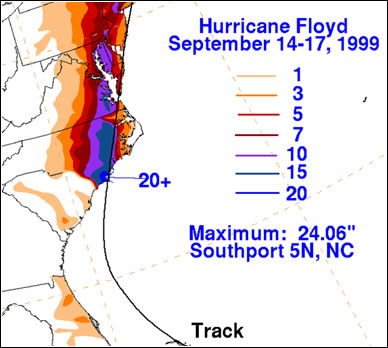
Greenville, NC September 24, 1999: Tar River were communities stranded in flooding waters in Pactolus, but north of Greenville. This family unit tin only accomplish their flooded home by boat. Photo past Dave Gatley/FEMA News Photo
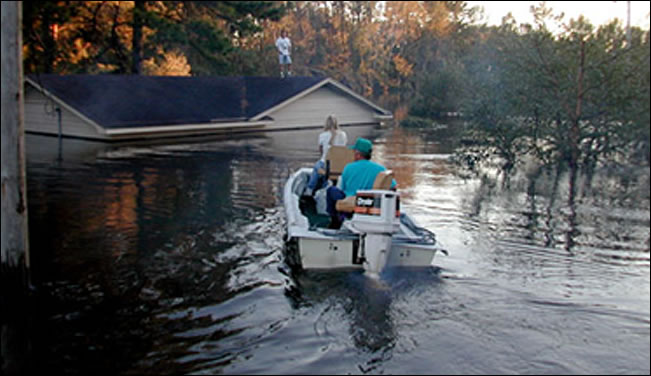
Edgecombe County, NC, September 19, 1999: Aerial view of severe flooding engulfing populated areas every bit a outcome of Hurricane Floyd. Photo by Dave Saville/ FEMA News Photo

North Carolina September 20, 1999: President Clinton talks with N Carolina residents about Hurricane Floyd and the resulting flooding during his trip to the Country. White House Photo
Learn More:
- NWS: Hurricane Floyd - 10th Anniversary
- NASA: Hurricane Floyd
- Hurricane Floyd, 1999
Alluvion Hazard Information
+Flash Flooding
Wink flooding is a rapid and farthermost menstruation of high h2o into a normally dry area, or a rapid water level rising in a stream or creek above a predetermined alluvion level, beginning within six hours of the causative outcome (i.e., intense rainfall, dam failure, ice jam). More data...
+River Flooding
River flooding occurs when river levels rise and overflow their banks or the edges of their principal channel and inundate areas that are normally dry. More information...
+Tropical Systems and Coastal Flooding
At whatsoever time of year, a tempest from over the ocean can bring heavy precipitation to the U.South. coasts. Whether such a tempest is tropical or not, prolonged periods of heavy precipitation tin can cause flooding in coastal areas, equally well as further inland as the storm moves on shore. More information...
+Dam Breaks/Levee Failure
A break or failure can occur with footling to no alarm. Virtually often they are acquired by water overtopping the structure, excessive seepage through the surrounding ground, or a structural failure. More data...
+Snowmelt
Flooding due to snowmelt almost frequently occurs in the spring when rapidly warming temperatures speedily melt the snow. The water runs off the already saturated ground into nearby streams and rivers, causing them to rapidly rise and, in some cases, overflow their banks.More information...
+Debris Jams
A back-upward of water into surrounding areas tin can occur when a river or stream is blocked past a build-upwardly of water ice or other droppings. Debris Jam: A back-upwards of water into surrounding areas tin occur when a river or stream is blocked past a build-up of debris. More data...
Source: https://www.weather.gov/safety/flood-states-nc
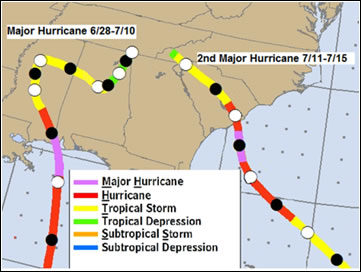
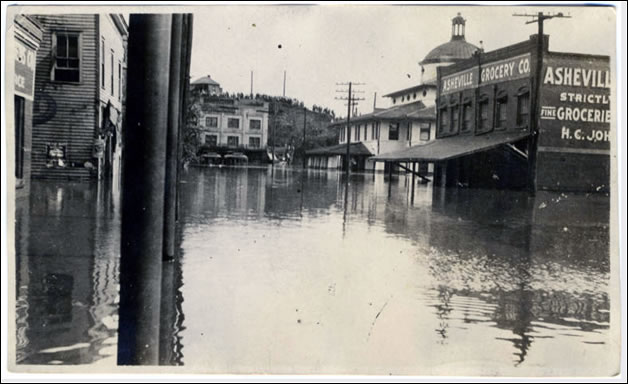
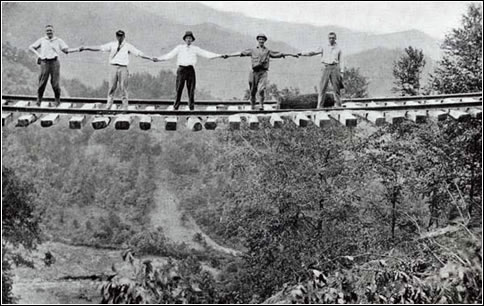
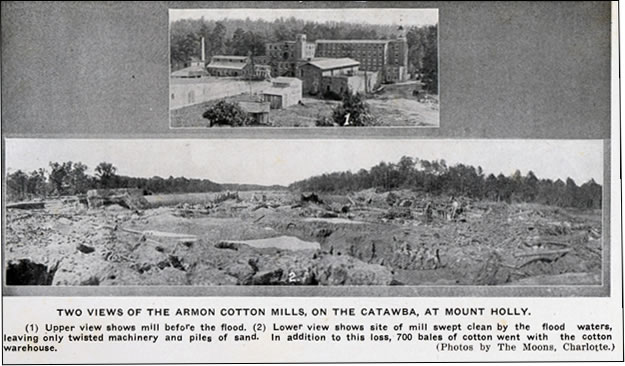
0 Response to "Is North Carolina Going to Flood Again"
Post a Comment